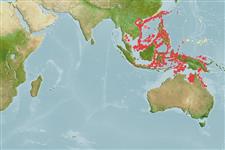>
Eupercaria/misc (Various families in series Eupercaria) >
Cepolidae (Bandfishes) > Cepolinae
Etymology: Acanthocepola: Greek, akantha = thorn + Latin, cepulla, cepa = onion.
More on author: Valenciennes.
Environment: milieu / climate zone / depth range / distribution range
ນິເວດວິທະຍາ
ສັດທະເລ ອາໄສຢູ່ໃກ້ໜ້າດິນໃຕ້ພື້ນທ້ອງນ້ຳ; ລະດັບຄວາມເລິກ 80 - 100 m (Ref. 43239). Temperate; 26°N - 20°S, 72°E - 149°E (Ref. 56298)
Indo-Pacific: India to Gulf of Papua; north to Japan; south to Australia.
ຂະໜາດ / ນ້ຳໜັກ / Age
Maturity: Lm ? range ? - ? cm
Max length : 50.0 cm TL ຕົວຜູ້/ບໍ່ມີເພດ; (Ref. 559)
ຄີຫຼັງຂອງປາ (ຄີອ່ອນ) (ທັງໝົດ) : 102 - 104; ຄີກົ້ນຂອງປາ: 105 - 107.
Adults pair and feed in loose groups; juveniles gather in small groups on deep sand slopes, usually in current-prone areas (Ref. 48635). Occurs in mud bottoms 15-100 m deep (Ref. 90102). Commonest member of the Japanese cepolid fishes. Caught by trawl net from sandy or muddy bottoms. Used mainly for fish cake. (Ref. 559 and 637). Minimum depth of 15 m reported from Ref. 90102.
Life cycle and mating behavior
ການຈະເລີນເຕັມໄວ | ການສືບພັນ | ການວາງໄຂ່ | ໄຂ່ | ຄວາມດົກຂອງໄຂ່ປາ | ຕົວອ່ອນ
Masuda, H., K. Amaoka, C. Araga, T. Uyeno and T. Yoshino, 1984. The fishes of the Japanese Archipelago. Vol. 1. Tokai University Press, Tokyo, Japan. 437 p. (text). (Ref. 559)
IUCN Red List Status (Ref. 130435: Version 2024-1)
Threat to humans
Harmless
Human uses
ການປະມົງ: ເປັນສີນຄ້າ
ເຄື່ອງມື
Special reports
Download XML
ແຫຼ່ງອີນເຕີເນັດ
Estimates based on models
Preferred temperature (Ref.
123201): 20.2 - 26.6, mean 24 °C (based on 40 cells).
Phylogenetic diversity index (Ref.
82804): PD
50 = 0.5625 [Uniqueness, from 0.5 = low to 2.0 = high].
Bayesian length-weight: a=0.00513 (0.00222 - 0.01187), b=2.82 (2.61 - 3.03), in cm total length, based on LWR estimates for this (Sub)family-body shape (Ref.
93245).
ຊັ້ນເຂດຮ້ອນ (Ref.
69278): 3.4 ±0.4 se; based on size and trophs of closest relatives
ຄວາມຢືດຢຸ່ນ (Ref.
120179): ຂະໜາດກາງ, ປະຊາກອນຕຳ່ສຸດທີ່ໃຊ້ເວລາສອງເທົ່າ 1.4 - 4.4 ປີ (Preliminary K or Fecundity.).
Fishing Vulnerability (Ref.
59153): Moderate vulnerability (40 of 100).
